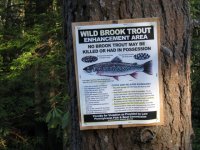Last point on this and I'll settle down a bit.
Just a thought experiment. What happens in 50 years when/if brook trout are federally listed? Pa would then list them at the state level. If you curry favor to a species that has been scientifically proven to be injurious to a species that is now listed, there's no way to unscramble that egg.
I know a lot of people like wild brown trout. The question is, if you protect them, how does that work out down the road if the native species gets listed for federal/state protections? See AZ, CO etc. for what they're dealing with now with cutthroat. Just because we have a somewhat robust population of brook trout today doesn't mean that it will be that way forever. Especially if we increase the number of nonnative fish competing with them.
Blanchet, S., G. Grenouillet, O. Beauchard, P. A. Tedesco, F. Leprieur, H. H. Dürr, F. Busson, T. Oberdorff, and S. Brosse. 2010. Non-native species disrupt the worldwide patterns of freshwater fish body size: implications for Bergmanns rule. Ecology Letters 13:421-431.
Carlson, S. M., A. P. Hendry, and B. H. Letcher. 2007. Growth rate differences between resident native brook trout and non-native brown trout. Journal of Fish Biology 71:1430-1447.
DeWald, L., M. A. Wilzbach. 1992. Interactions between native brook trout and hatchery brown trout: effects of habitat use, feeding, and growth. Transactions of the American Fisheries Society 121:287-296.
Fausch, K. D., and R. J. White. 1981. Competition between brook trout (Salvelinus fontinalis) and brown trout (Salmo trutta) for positions in a Michigan stream. Canadian Journal of Fisheries and Aquatic Sciences 38:1220-1227.
Halverson, M. A. 2008. Stocking trends: a quantitative review of governmental fish stocking in the United States, 1931 to 2004. Fisheries 33:69-75.
Hitt, N., E. Snook, and D. Massie. 2017. Brook trout use of thermal refugia and foraging habitat influenced by brown trout. Canadian Journal of Fisheries and Aquatic Sciences 74:406-418.
McKenna, J. E., M. T. Slattery, and K. M. Clifford. 2013. Broad-scale patterns of brook trout responses to introduced brown trout in New York. North American Journal of Fisheries Management 33:1221-1235.
Tebo, L. B., and W. W. Hassler. 1963. Food of brook, brown, and rainbow trout from streams in Western North Carolina. Journal of the Elisha Mitchell Scientific Society 79:44-53.
Wagner, T., J. T. Deweber, J. Detar, and J. Sweka. 2013. Landscape?scale evaluation of asymmetric interactions between brown trout and brook trout using two?species occupancy models. Transactions of the American Fisheries Society 142:353-361.
Waters, T. F. 1983. Replacement of brook trout by brown trout over 15 years in a Minnesota stream: production and abundance. Transactions of the American Fisheries Society 112:137-146.
and on and on and on and on...





